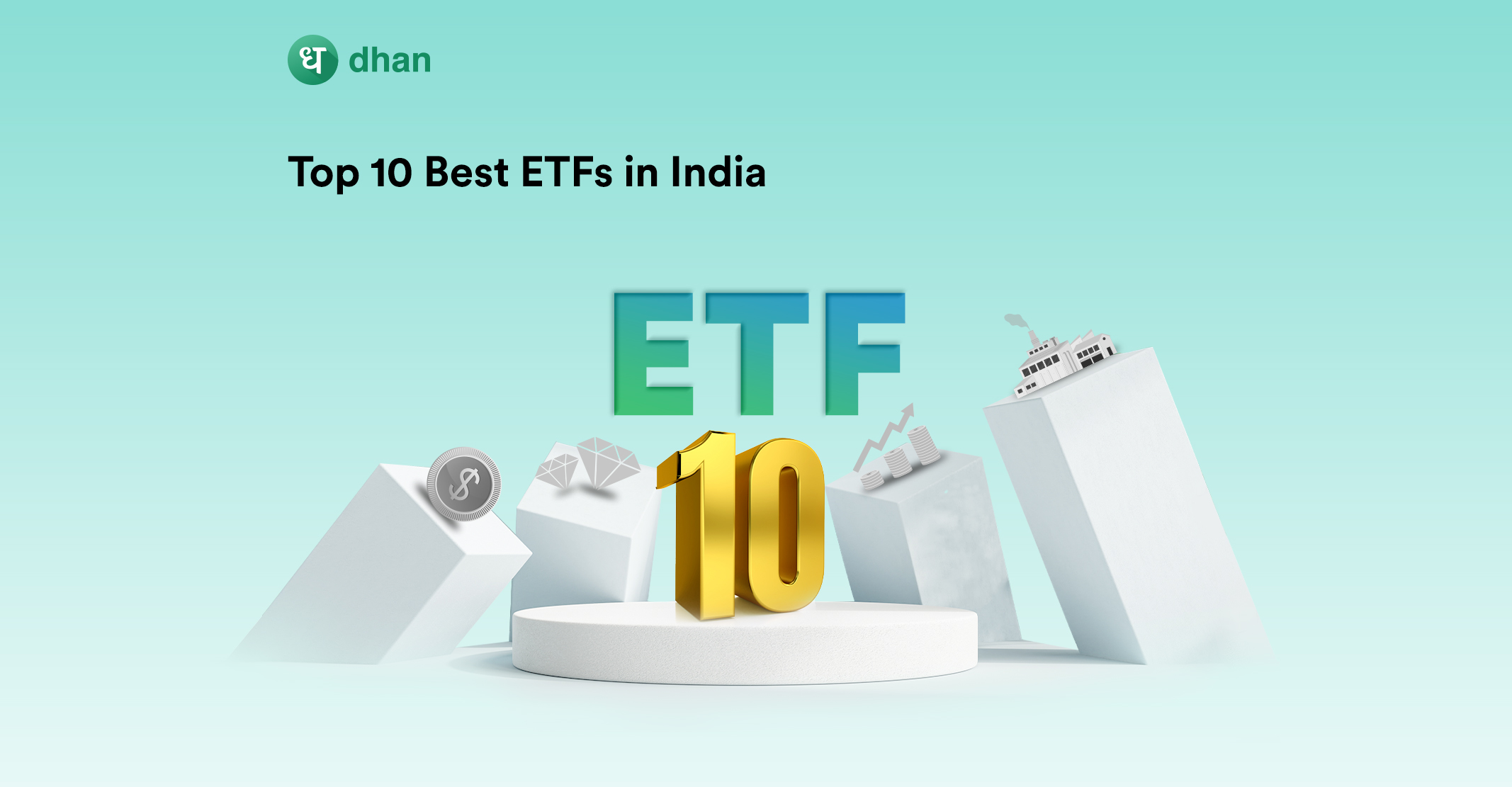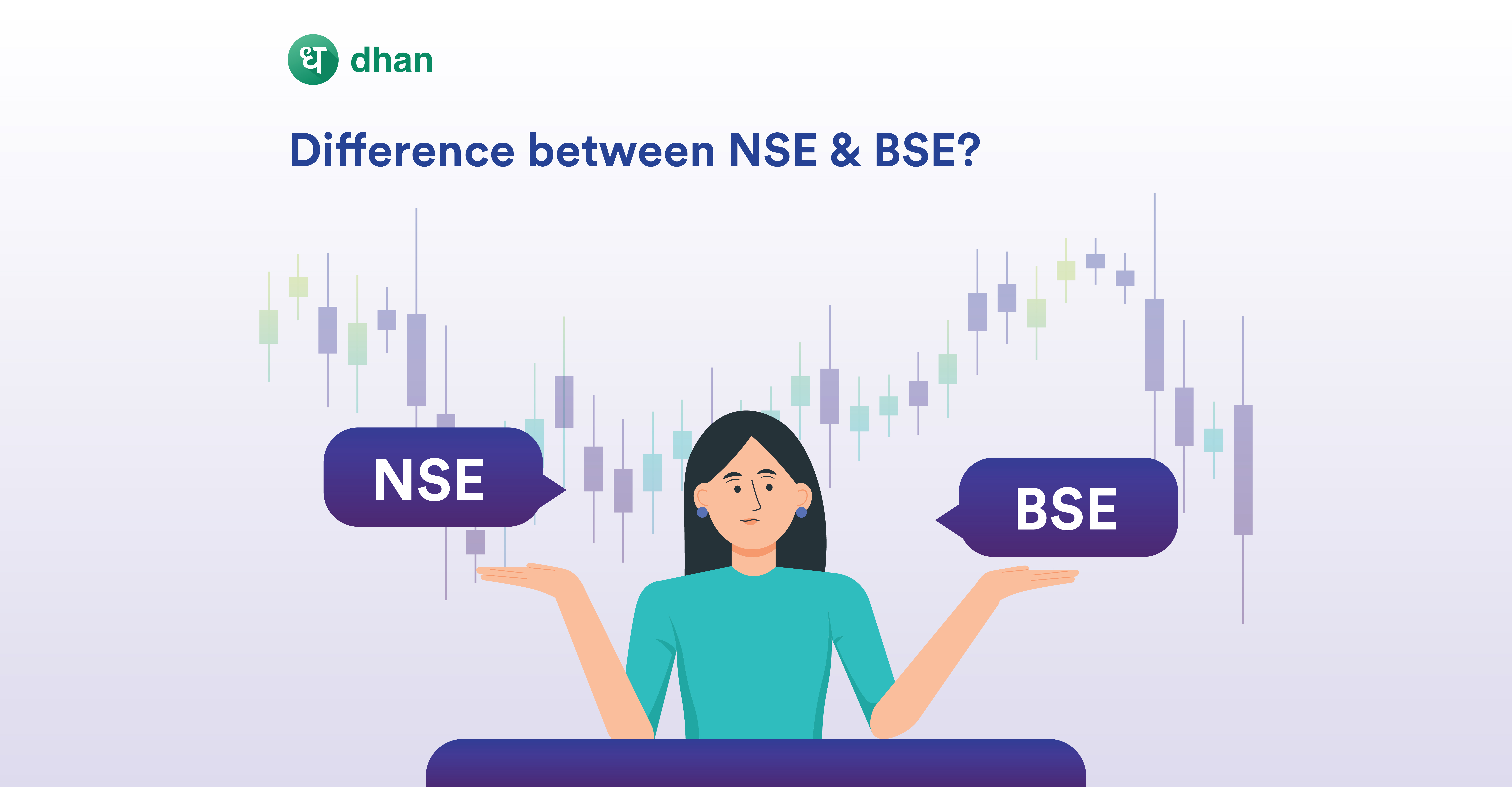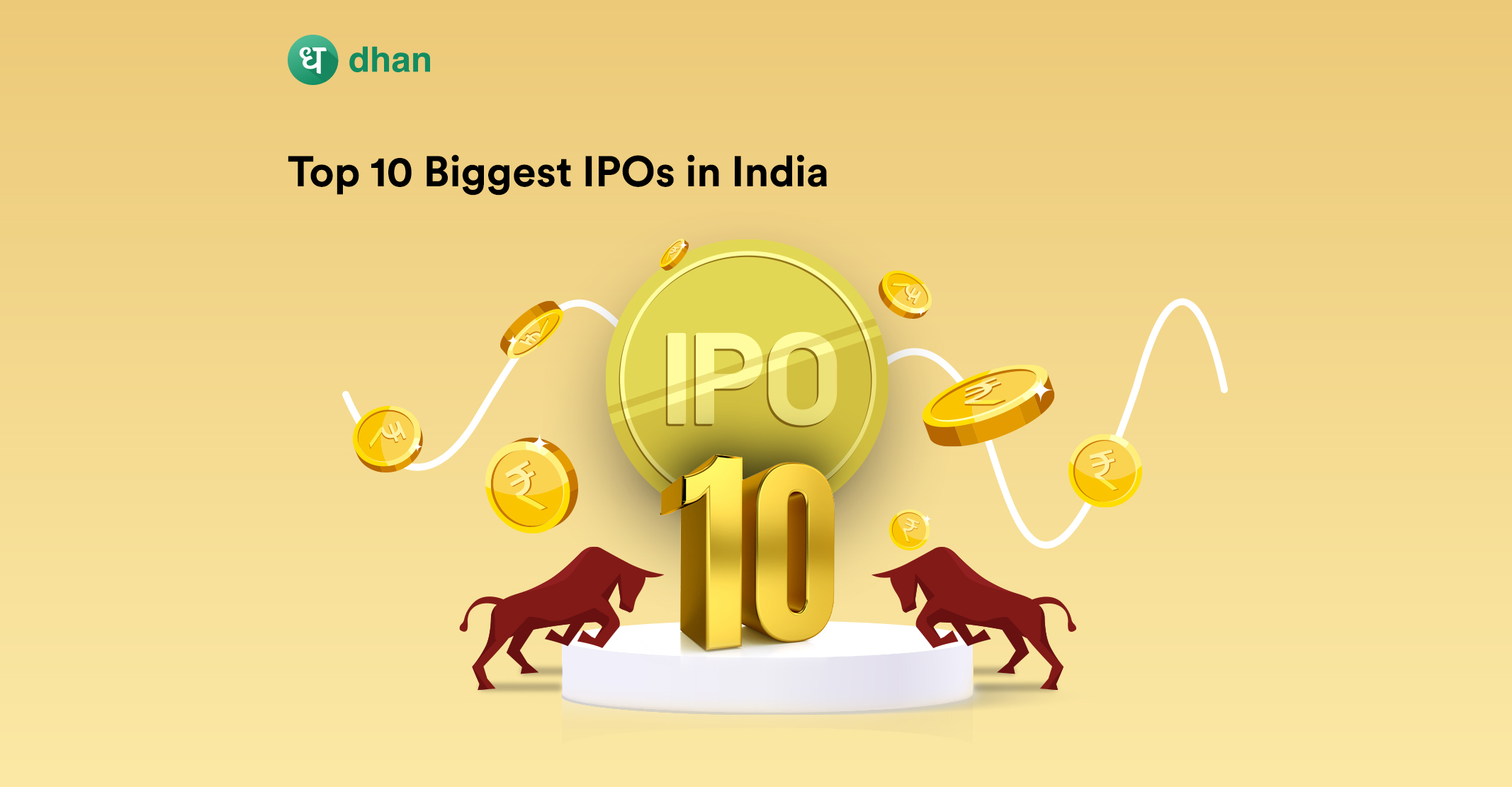India’s oldest Exchange Traded Fund (ETF) has generated over 1000% returns since its launch in 2002. But does that mean it’s one of the best ETFs in India for investment? Read on to find out!
Top 10 Best ETFs in India for 2023
An ETF is a passive investment option that is designed to be low-effort and low-cost. But the world of ETFs is vast. There are ETFs that track Indian indices like Nifty while others track bonds, commodities, and global indices.
To make your research that much simpler, we’ve arranged the top ETFs in India by market capitalization. Bear in mind that ETFs are a type of mutual fund, so market cap in this context means Assets Under Management (AUM).
| Name | Ticker Symbol | AUM (in Rs) | Current Price (in Rs) |
| SBI Nifty 50 ETF | SETFNIF50 | 1,28,116 crores | 177.96 |
| SBI S&P BSE SENSEX ETF | 535276 | 65,627 crores | 616.67 |
| UTI-S&P BSE Sensex ETF | UTISENSETF | 20,643 crores | 612.80 |
| CPSE ETF | CPSEETF | 17,130 crores | 34.20 |
| BHARAT Bond ETF – April 2030 | EBBETF0430 | 13,615 crores | 1,196.00 |
| BHARAT Bond ETF – April 2031 | EBBETF0431 | 10,504 crores | 1,067.98 |
| BHARAT Bond ETF – April 2025 | EBBETF0425 | 10,034 crores | 1,075.05 |
| Nippon India ETF Nifty 50 BeES | NIFTYBEES | 8,707 crores | 189.13 |
| Nippon India ETF Nifty Bank BeES | BANKBEES | 8,705 crores | 380.82 |
| BHARAT Bond ETF – April 2032 | BBETF0432 | 6,851 crores | 1,000.40 |
1. SBI Nifty 50 ETF
This features on the list of top ETFs as its AUM stands at Rs. 1,28,116 crores. SBI Nifty 50 ETF was launched on July 22nd, 2015. Like most mutual funds, ETFs are managed by fund houses, which is SBI in this case.
SBI has designed the ETF to mirror Nifty 50, an index that tracks the 50 of the biggest stocks in India. Because of this, the portfolio of SBI Nifty 50 ETF is geared toward blue-chip stocks, including (but not limited to):
That said, it also includes midcap stocks in a relatively small proportion. Overall, the SBI Nifty 50 ETF has generated returns similar to Nifty 50’s ever since its launch (11.75% Vs 11.91%) and has an expense ratio of 0.07%.
2. SBI S&P BSE SENSEX ETF
While the previous ETF from SBI mirrored Nifty 50, this one tracks Sensex – an index that contains 30 of the biggest stocks in India. SBI S&P BSE Sensex ETF was launched on March 8th, 2013 – mere days after the 2013 Union budget.
Since it mirrors Sensex, this top ETF contains 30 stocks that fall in the blue-chip and large-cap categories, including:
The ETF has an AUM of Rs. 65,627 crores, making it one of the biggest ETFs in India by market cap. The ETF has generated similar returns to Sensex since its inception (13.86% vs 14.91%).
3. UTI-S&P BSE Sensex ETF
This Sensex ETF is managed by UTI Mutual Fund, which is one of India’s oldest AMCs. UTI-S&P BSE Sensex ETF was launched on September 1st, 2015. Just like the previous ETF, this one also mirrors Sensex.
That’s why this Sensex ETF’s portfolio contains stocks of companies like:
- HDFC Bank
- ICICI Bank
- HUL
- Larsen & Toubro
- Infosys
UTI-S&P BSE Sensex ETF’s AUM is Rs. 20,643 crores and the ETF has generated returns that are more or less in line with the index it tracks (13.88% vs 14.91%) with an expense ratio of 0.07%.
4. CPSE ETF
CPSE ETF or Central Public Sector Enterprises ETF was launched on March 28th, 2014 – a day after India was declared Polio-free by WHO. CPSE ETF invests in the shares of Maharatna, Navaratna & Miniratna companies.
The criteria to get these titles varies, but companies in the CPSE index rope in the big bucks. The top holdings of CPSE ETF thus include stocks like:
The AUM of this ETF is Rs. 17,130 crores while the returns since inception stand at 8.54%. You’ll notice that the returns are in line with Nifty 50 as well. The expense ratio of CPSE ETF is 0.01%.
5. Bharat Bond ETF – April 2030
Launched on December 26th, 2019, the ETF invests in various types of debt instruments like debentures, government securities, and bonds that mature on or before 2030.
That’s why this ETF contains the suffix “2030”. The debt instruments that Bharat Bond ETF – 2030 invests in have a high credit rating. In fact, it’s similar to the Nifty BHARAT Bond Index – April 2030.
Here’s a look at some of the debentures and bonds in its portfolio:
| Name | Type | Credit Rating |
| 7.03% Hindustan Petroleum Corporation 2030 | Debenture | AAA |
| 7.41% Power Finance Corporation 25/02/2030 | Debenture | AAA |
| 7.70% Nat. Highways Authority 13/09/2029 | Non-Convertible Debenture | AAA |
| 6.45% GOI 2029 | GOI Securities | SOV |
| 8.25% REC 26/03/2030 | Bond | AAA |
The AUM of Bharat Bond ETF – 2030 is Rs. 13,615 crores with one of the lowest expense ratios of any ETF at 0.0005%. That said, this ETF invests in long-term debt instruments that are known to be impacted by interest rate changes.
Bharat Bond ETF – April 2030 is the first of many debt ETFs to feature on this list. Next up, is BHARAT Bond ETF – April 2031.
6. BHARAT Bond ETF – April 2031
This ETF is built to mirror the Nifty Bharat Bond – April 2031 index. It was launched on July 23rd, 2020 and invests in bonds, debentures, and government securities that are at least AAA rated.
The debt instruments in the portfolio of BHARAT Bond ETF – April 2031 mature on or before 2031. That’s why there’s 2031 in the suffix. Here’s a snapshot of the debt ETF’s portfolio.
| Name | Type | Credit Rating |
| 6.41% Indian Railway Finance Corporation 2031 | Debenture | AAA |
| 6.90% REC 31/03/2031 | Debenture | AAA |
| 6.45% National Bank Agr. Rur. Devp 2031 | Debenture | AAA |
| 7.61% GOI 2030 | GOI Securities | SOV |
| 8.32% Power Grid Corporation 23/12/2030 | Bond | AAA |
BHARAT Bond ETF – April 2031’s AUM is Rs. 10,504 crores with a negligible expense ratio just like other debt ETFs.
7. BHARAT Bond ETF – April 2025
BHARAT Bond ETF – April 2025 is designed to have similar components to Nifty BHARAT Bond – April 2025 index. That’s why bonds and debentures like these make its portfolio:
| Name | Type | Credit Rating |
| 5.36% Hindustan Petroleum Corpn. Ltd. 11/04/2025 | Debenture | AAA |
| 5.47% National Bank For Agriculture & Rural Development 11/04/2025 | Debenture | AAA |
| 5.77% Power Finance Corpn. Ltd. 11/04/2025 | Debenture | AAA |
| 9% National Thermal Power Corp. Ltd. 25/01/2025 | Bond | AAA |
| 6.88% National Housing Bank 21/01/2025 | Bond | AAA |
BHARAT Bond ETF – April 2025 manages Rs. 10,034 crores and has an expense ratio of 0.0005%. The ETF has generated ~3.60% returns since it was launched on 23rd June, 2020.
8. Nifty 50 BeES
This entry may not be surprising to many. Nifty Benchmark Exchange-Traded Scheme is the oldest ETF in India. Launched in 2002, it mirrors the Nifty 50 index and is known as Nifty BeES.
Since the ETF is similar to Nifty 50, it has overlapping components. Here’s a snapshot of stocks in Nifty BeES’ portfolio:
- Reliance Industries
- Infosys
- ITC
- Axis Bank
- Asian Paints
Nifty BeES has an AUM of Rs. 8,707 crores and has generated 12.84% returns over the past 5 years while Nifty 50 has given a return of 12.94%. This Nifty 50 ETF has an expense ratio of 0.13%.
9. Nifty Bank BeES
This ETF was launched on 27th May 2004 and is designed to track the Nifty Bank index. That’s why Nifty Bank BeES’ portfolio includes stocks of popular banks like:
- HDFC Bank
- ICICI Bank
- State Bank of India
- Axis Bank
- Kotak Mahindra Bank
The AUM of Nifty Bank BeES stands at Rs. 8,705 crores with an expense ratio of 0.19%. The returns generated by Nifty Bank BeES in the last 5 years was 33.12% while Nifty Bank returned 76.29% during the same period.
10. BHARAT Bond ETF – April 2032
Another Bharat Bond ETF on the list. This ETF is built to mirror the Nifty Bharat Bond April 2032 index. Its portfolio consists of debt instruments that mature on or before 2032. Hence the suffix 2032.
These debt instruments include:
| Name | Type | Credit Rating |
| 8.24% NHPC LTD SER U NCD RED 27-06-2031 | Debenture | AAA |
| 6.89% IRFC NCD RED 18-07-2031 | Debenture | AAA |
| 6.92% IRFC NCD SR 161 RED 29-08-2031 | Debenture | AAA |
| 6.54% GOVT OF INDIA RED 17-01-2032 | GOI Securities | SOV |
| 6.74% NTPC LTD RED 14-04-2032 | Bond | AAA |
Launched on 13th December 2021, BHARAT Bond ETF – April 2032 has an AUM of Rs. 7,343 crores with an expense ratio of 0.0005%. The ETF has generated negative returns since launch.
Factors to Consider Before Investing in ETFs
Acquiring essential knowledge about an asset like ETFs can help you make informed decisions. In fact, the first step to becoming an informed investor is to understand your risk profile and investment goals.
1. Your Risk Profile
As an investor or trader, it’s important to understand the level of risk you can absorb while creating wealth. This can be understood by evaluating your risk profile, which is a combination of many factors like your:
- Income
- Age
- Liabilities
Once you’ve understood your risk profile, you’ll be able to determine whether or not investing in ETFs is right for you. More importantly, it’ll help you determine if ETFs can help you achieve your financial goals.
2. Financial Goals
A financial goal is a time-bound achievement that you want to unlock by investing or trading ETFs, stocks, commodities, currencies, and other assets. These goals are split across terms:
- Short-term (0-3 years)
- Medium-term (3-5 years)
- Long-term (5+ years)
While this may seem obvious, the average investor may fail to acknowledge the importance of investing based on financial goals. In fact, the entire purpose of investing is to achieve financial goals.
That’s why an investor can benefit from narrowing down and writing down their financial goals. This, coupled with a strong idea of risk profiles, may help you understand whether ETFs are right for you.
3. Cost of Investment
While ETFs are known to be low-cost investments, they carry an expense ratio and taxes just like any other investment. Entry loads, exit loads, expense ratios, taxes, and more can eat into your profits.
Evaluating whether you can create lucrative wealth post-tax and fees from ETFs can help answer the question of “Are ETFs a good investment?”. P.S: Dhan allows SIPs in ETFs – an industry-first feature.
How to Invest in ETFs in India?
You can start investing in ETFs by opening a Demat account with a stockbroker. At the end of the day, ETFs are traded like shares and you’ll need a place to store them – that’s what a Demat account is for.
To open a Demat account, you’ll have to complete a KYC process that can take T+1 days or more depending on your broker. Dhan has lightning-fast KYC, which means you can open an account in 10 minutes or less.
Once you have a Demat and trading account, you’ll need to evaluate the factors covered in this section and more before you decide whether or not to invest in ETFs.
Should You Invest in ETFs?
Exchange Traded Funds or ETFs have become a boon for long-term investors looking for a low-cost, low-effort solution for wealth creation. ETFs typically don’t look to beat the market. Rather, they simply look to grow with it.
Even then there are ETFs in India that have outperformed stocks. For example, HDFC Bank’s share has generated close to 60% returns in the past 5 years. HDFC Nifty 50 generated more than 80% returns in the same period.
That said, a one-size-fits-all is not known to work in the world of investing. That’s why you’ll need to understand your risk profile, evaluate your financial goals, and consider other factors before investing in ETFs.
FAQs
1. Is ETF good for the long term in India?
An ETF is known to be a good long-term investment because it can grow with the stock market. In India, indices like Sensex and Nifty which are synonymous with the term markets have grown exponentially over the past two decades. ETFs look to tap into this growth and generate returns on par with the market.
2. How long can I hold ETF?
You can hold an ETF as long as you want to. There is no lock-in period in the case of an open-ended fund like ETFs. Investors and traders can buy and sell an ETF at any time based on their financial goals.
3. Do ETFs pay dividends?
Yes, ETFs pay dividends in India. An ETF holds multiple stocks in its portfolio. Some of them may pay dividends which the ETF will redistribute to its investors. However, ETF dividend yields are known to be low.
4. What are the disadvantages of ETFs?
While ETFs are widely accepted to be solid investments, there are disadvantages to investing in ETFs:
- High Fees: the overall cost of investing in an ETF also includes an expense ratio that is not applicable to regular stocks
- Low Dividends: ETFs are known to have a lower dividend yield than regular stocks
- Stable Returns: Most ETFs are designed to grow with the markets which means they may not generate significantly high returns like certain individual stocks
Disclaimer: This blog is not to be construed as investment advice. Trading and investing in the securities market carries risk. Please do your own due diligence or consult a trained financial professional before investing.




Comments are closed.